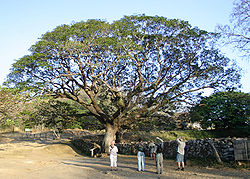Samanea
| Samanea | |
|---|---|
 | |
| Scientific classification | |
| Kingdom: | Plantae |
| Clade: | Tracheophytes |
| Clade: | Angiosperms |
| Clade: | Eudicots |
| Clade: | Rosids |
| Order: | Fabales |
| Family: | Fabaceae |
| Subfamily: | Caesalpinioideae |
| Clade: | Mimosoid clade |
| Genus: | Samanea (Benth.) Merr. (1916) |
Samanea is a genus of flowering plants in the family Fabaceae. It includes four species of trees native to the tropical Americas, ranging from Belize to Paraguay, and to the Democratic Republic of the Congo in central Africa. Habitats include tropical moist evergreen and seasonally-dry deciduous forest, woodland, and wooded grassland.[1] It belongs to the mimosoid clade of the subfamily Caesalpinioideae.[2] The type species is Samanea saman from South America.
Taxonomy
[edit]The name Samanea comes from saman in Spanish derived from zamang used for Samanea saman,[3] this giant S. saman tree was seen by Alexander von Humboldt near Maracay, Venezuela in 1799 when he travelled to the Americas from that year to 1804.[3][4]
Species
[edit]Plants of the World Online lists the following accepted species:[1]
- Samanea guineensis (G.C.C.Gilbert & Boutique) Brenan & Brummitt
- Samanea inopinata (Harms) Barneby & J.W.Grimes
- Samanea saman (Jacq.) Merr.
- Samanea tubulosa (Benth.) Barneby & J.W.Grimes
References
[edit]- ^ a b "Samanea (Benth.) Merr". Plants of the World Online. Royal Botanic Gardens, Kew. 2023. Retrieved 19 September 2023.
- ^ The Legume Phylogeny Working Group (LPWG). (2017). "A new subfamily classification of the Leguminosae based on a taxonomically comprehensive phylogeny". Taxon. 66 (1): 44–77. doi:10.12705/661.3. hdl:10568/90658.
- ^ a b Allen, O. N.; Allen, Ethel K. (1981). The Leguminosae, a source book of characteristics, uses, and nodulation. Madison, Wisconsin, USA: University of Wisconsin Press. p. 590. ISBN 978-0-299-08400-4.
- ^ von Humboldt, Alexander; Bonpland, Aimé (1815). Reise in die Aequinoctial-Gegenden des neuen Continents. Vol. 3. Stuttgart and Tübingen, Germany: J.G. Cotta.


 French
French Deutsch
Deutsch